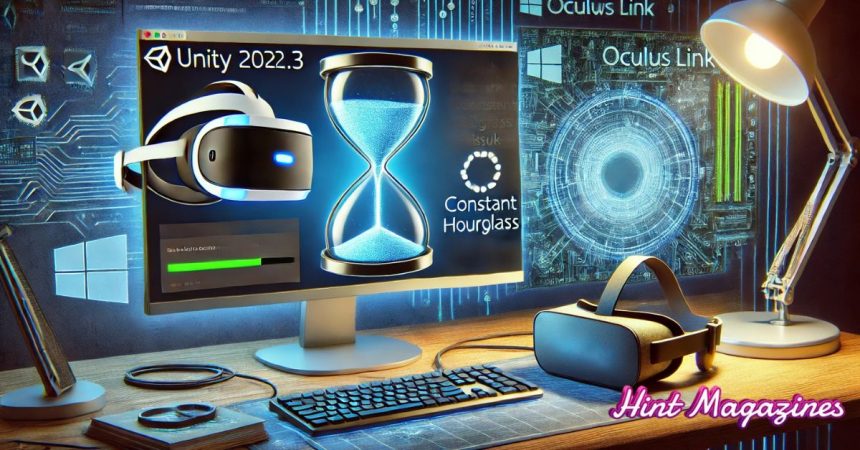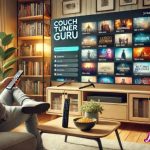Imagine you’re ready to explore the immersive worlds of VR, but instead, you’re stuck staring at an endless hourglass. Frustrating, right? This common issue with Unity 2022.3, Oculus Link, and Windows 11 has been a hurdle for many VR developers and enthusiasts. Whether you’re a professional creating the next considerable VR experience or just an enthusiast wanting a seamless experience, this blog post aims to help you solve this problem. We’ll walk you through the solutions step-by-step, ensuring you get back to the heart of VR without the pesky hourglass in sight.
Understanding the Oculus Link Hourglass Issue
The Oculus Link hourglass issue is a well-known problem among users working with Unity 2022.3 and Windows 11. This issue often occurs when attempting to connect the Oculus Quest headset via Oculus Link, resulting in an unending hourglass rather than the desired VR experience. It’s a barrier to productivity and enjoyment, but understanding the root cause helps find a solution.
The underlying problem often relates to compatibility and performance concerns between Unity, Oculus software, and the Windows 11 operating system. Each component must be in sync, and a misalignment in software versions or system settings can trigger this issue. By identifying these discrepancies, we can tackle the problem effectively.
Knowing how these systems interact is crucial. Unity acts as the development environment, Oculus Link bridges the headset and the PC, and Windows 11 is the operating system platform. A glitch in any of these links can lead to the dreaded hourglass, making understanding these interactions vital.
Ensuring Unity 2022.3 Compatibility
Unity’s 2022.3 version offers many advanced features for VR development, but compatibility can sometimes pose challenges. Ensuring your Unity setup functions correctly with Oculus Link and Windows 11 is essential to overcoming the hourglass issue.
The first step is verifying that Unity is updated to the latest version. Updates often include critical bug fixes and improvements that can resolve compatibility issues. By running the latest version, you ensure that Unity developers have addressed any known problems with Oculus Link.
Unity’s settings are also vital. Ensure that the VR modules are correctly installed and configured within Unity. This setup enables the software to communicate seamlessly with Oculus Link, reducing the chance of encountering the hourglass problem.
Configuring Oculus Link Settings
Oculus Link transforms the Oculus Quest into a PC VR headset, but proper setup is essential for smooth operation. The hourglass issue often stems from incorrect settings within the Oculus software.
Begin by updating the Oculus software to its latest version. Like Unity, updates can resolve compatibility issues and enhance performance, reducing the likelihood of encountering the hourglass. Ensure that both the Oculus app on your PC and the firmware on the Quest headset are up-to-date.
Next, check the Oculus Link settings. Adjustments in resolution and refresh rate can improve performance. Higher settings can lead to resource bottlenecks, causing the hourglass problem. Experiment with these settings to find a balance that maintains visual quality without compromising performance.
Tweaking Windows 11 for Optimal Performance
Windows 11 introduces new features and changes that can impact VR performance. Configuring your system to support VR can help eliminate the hourglass issue when using Oculus Link with Unity 2022.3.
Start by ensuring that your PC meets the hardware requirements for running VR applications. Insufficient resources can lead to performance issues. Check for the latest graphics drivers, crucial for VR performance and compatibility with Oculus Link.
Windows 11’s settings can also contribute to the issue. Disable unnecessary background applications that consume resources and ensure your power settings are configured to prioritize performance over energy saving. These changes can free up system resources, helping to prevent the hourglass from appearing.
Updating Graphics Drivers
Graphics drivers play a pivotal role in ensuring seamless VR experiences. Outdated or incompatible drivers, including the Oculus Link hourglass problem, can lead to performance issues.
Check for updates from your graphics card manufacturer regularly. Nvidia and AMD frequently release updates that address compatibility issues and enhance VR applications’ performance. Keeping your drivers updated can prevent many common problems.
If updating doesn’t resolve the problem, consider returning to a previous driver version. Sometimes, new updates introduce bugs that can affect specific setups. Experimenting with different driver versions can help identify a stable configuration for your system.
Checking USB Connections
The connection between your Oculus Quest and PC can significantly impact performance. A faulty or improper USB connection might be causing the hourglass issue with Oculus Link.
Use a high-quality USB 3.0 cable. Oculus Link requires the bandwidth of USB 3.0 to function correctly, and using a lesser cable can lead to connectivity issues. Test different cables to find one that provides a stable connection.
USB port selection is also crucial. Use a port directly connected to your motherboard rather than an extension or hub. Direct connections often offer more stable data transfer, reducing the chance of encountering the hourglass issue.
Optimizing Network Settings for VR
While Oculus Link primarily relies on USB connections, network settings can also contribute to performance issues. Ensuring your network is optimized can contribute to a smoother VR experience.
If using Oculus Air Link, ensure your Wi-Fi network supports the bandwidth for VR streaming. A congested or weak network can result in delays or poor performance, leading to hourglass issues.
Consider using Ethernet connections for your PC to ensure a stable internet connection. While not directly related to Oculus Link via USB, a stable network can help ensure that any required online resources are available without delay, contributing to overall performance.
Managing Background Processes
Background processes can consume significant system resources, affecting VR performance. Identifying and managing these processes can help eliminate the hourglass problem with Oculus Link.
Use Task Manager to identify resource-heavy applications running in the background. Close any unnecessary programs to free up CPU and memory resources, ensuring your system prioritizes VR performance.
Consider using a dedicated game mode available in Windows 11. This mode optimizes system resources for gaming applications, ensuring that VR experiences have the bandwidth and processing power to run smoothly.
Troubleshooting Oculus Software
Sometimes, issues with the Oculus software can lead to hourglass problems. Troubleshooting these software-specific issues can help resolve the problem and restore VR functionality.
Try reinstalling the Oculus software on your PC. A fresh installation can clear out any corrupted files or settings contributing to the hourglass issue. Ensure that you back up any critical data before uninstalling.
If the problem persists, consider contacting Oculus support. They can provide insights and guidance specific to your setup and potentially identify obscure configuration issues contributing to the problem.
Testing with Alternative Applications
If you’ve exhausted other options, testing Oculus Link with alternative applications can help determine if the issue is specific to Unity 2022.3 or a broader system problem.
Try running different VR applications or games. If the hourglass issue persists across various applications, the problem may lie with your system settings or connectivity rather than Unity.
This testing can help narrow down the problem, allowing you to focus your troubleshooting efforts on the area causing the hourglass issue.
Community Solutions and Forums
Online communities and forums can be invaluable resources when troubleshooting the Oculus Link hourglass issue. Many users share their experiences and solutions, providing potential fixes that may not be immediately obvious.
Join Oculus and Unity forums to connect with other users experiencing similar issues. Engaging with these communities can provide new insights and solutions you may not have considered.
Be open to trying different solutions shared by the community. The collective knowledge of these forums often leads to innovative fixes that address niche problems like the Oculus Link hourglass.
Considering Hardware Upgrades
If all else fails, consider whether your hardware meets the demands of modern VR applications. In some cases, hardware limitations may be the root cause of the hourglass issue with Oculus Link.
Evaluate your system’s specifications against the requirements for running VR applications. Upgrading components like your graphics card, RAM, or CPU can significantly boost performance, reducing the chance of encountering the hourglass problem.
While hardware upgrades represent a more significant investment, they can future-proof your system for a more seamless VR experience, providing long-term benefits for both gaming and development purposes.
Conclusion
Dealing with the Oculus Link hourglass issue in Unity 2022.3 on Windows 11 can be frustrating, but with the right approach, it’s a problem that can be overcome. By understanding the interplay between Unity, Oculus, and Windows and systematically addressing potential issues, you can restore your VR experience to its full potential. Whether updating software, optimizing settings or considering hardware changes, these strategies can guide you back to an immersive, glitch-free virtual world. For additional insights and community-driven solutions, explore forums and resources related to VR development to keep your finger on the pulse of evolving VR technology.





